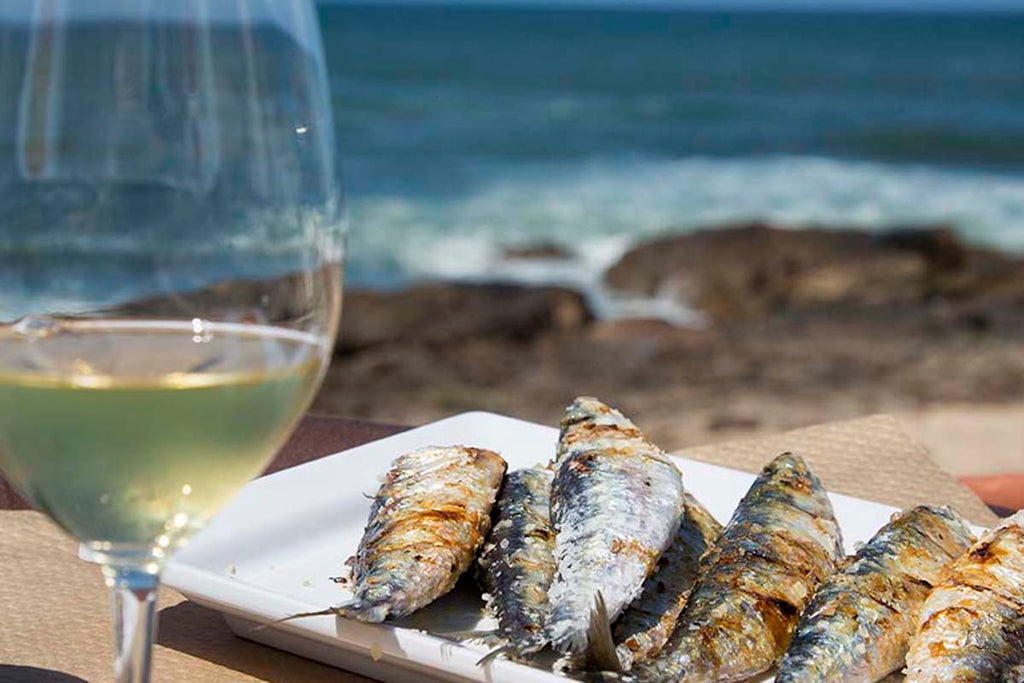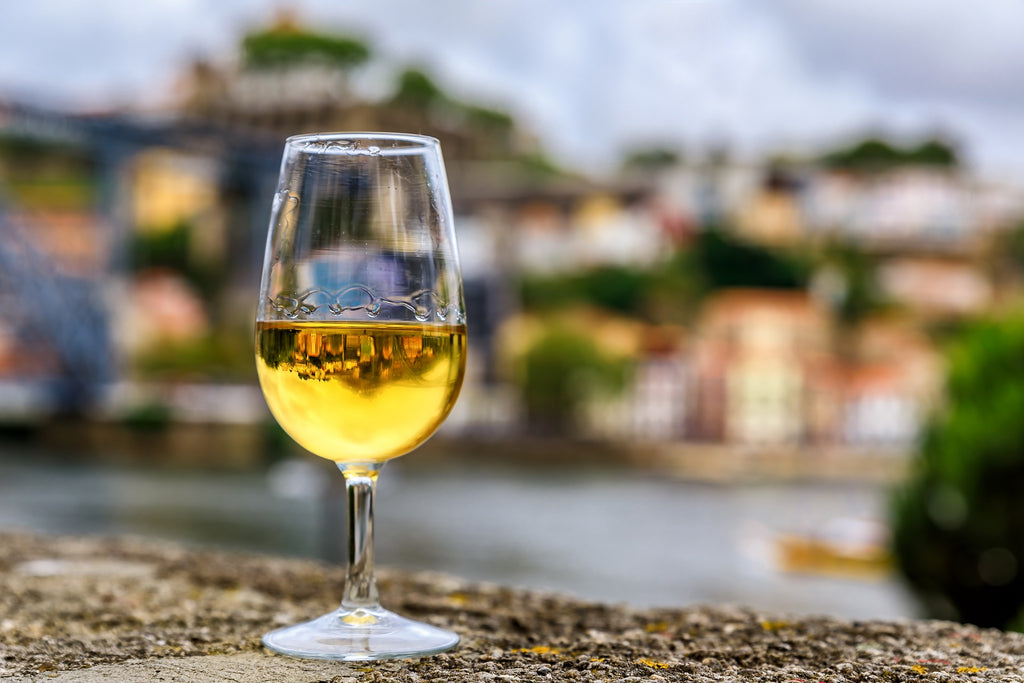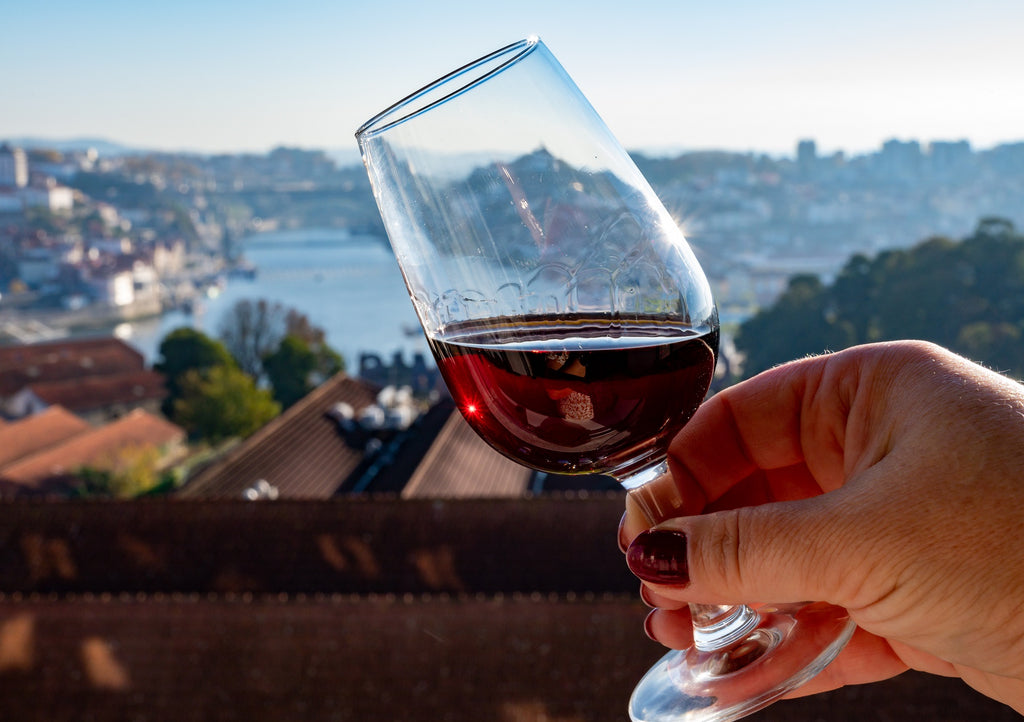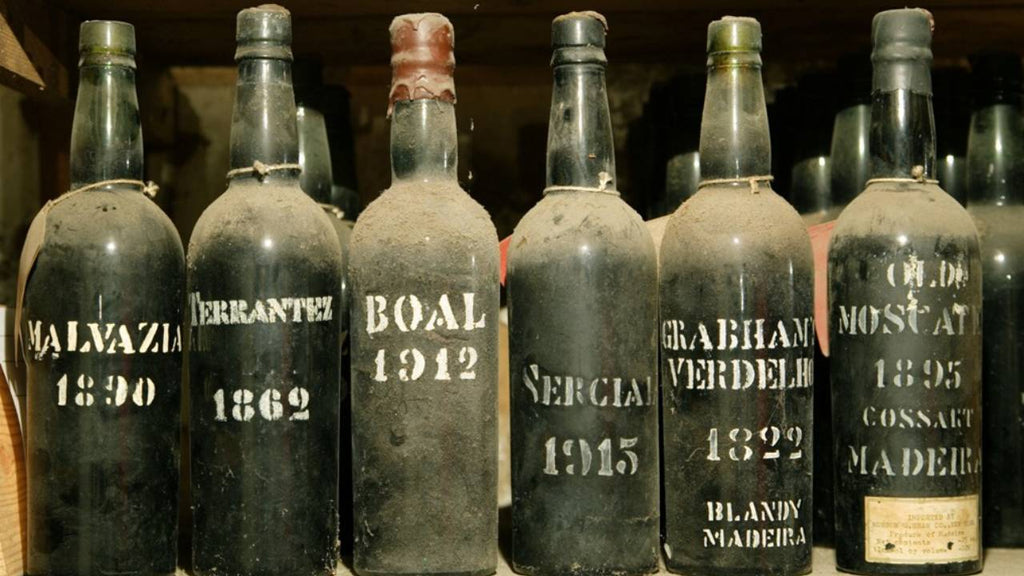Portugal cultivates more than 250 grape varieties, which allows it to produce a great diversity of wines with very distinct personalities. There are, as everywhere, red, white and rosé wines. There are also green wines, sparkling wines, wines from Porto, Madeira and the Azores as well as Moscatel.

White wines
Light and fresh white wines
They are sweet and aromatic wines, where floral and fruity notes predominate. They usually have a firm acidity and low alcohol content. The wines that best illustrate this style are called Bucelas and Vinho Verde.
These light and mineral, taut and crystalline wines are made from local grape varieties: Arinto in the case of Bucelas and Alvarinho, Loureiro, Azal, Trajadura and Pedernã in the case of Vinho Verde.

Vinho Verde - Credit Descubra Lisboa
These wines should be drunk young and fresh. They are ideal partners for the summer, although they can be drunk all year round as an aperitif, with salads or fish and seafood dishes.
Structured white wines
Slightly alcoholic and rich in texture, these wines are born in the vineyards under the hot sun and hot summers. These wines are sweet and rich when born in the Alentejo, intense and mineral when from the Douro and full-bodied when from Trás-os-Montes.

Vinho Branco - Credit Revista Sociedade da mesa
Portugal has the advantage of having countless grape varieties that can retain acidity in hot climates and use it to add freshness to a structured blend.
Structured whites can be enriched by oak fermentation, which makes them denser and more structured, and/or oak maturation, which gives them light or strong woody aromas.
These are wines that pair well with strong flavored foods. Wines with woody aromas are more difficult to pair with food, but they can work well with smoked foods.
Rosé wines
Rosé wines have a slight acidity, low alcohol content and light body, especially when grown in cooler areas of maritime influence or high altitude.
Portugal is a country of rosés, as evidenced by many brands with a strong international presence, universal symbols such as Mateus and Lancers. There is no Portuguese region where you can't find rosé wine.

Vinho Rosé - Credit Revista Sociedade da mesa
Rosés are a fresh and fruity alternative to dry whites. Most rosés go well with all foods and can be a good, low-alcohol way to accompany a summer barbecue. Dry, fruity rosés are perfect with a variety of lightly spiced dishes, including sushi, vegetables and salads, because of their light sweetness.
Red wines
Sweet and aromatic red wines
The vineyards of Portugal's Atlantic coast produce light, aromatic red wines and generally have an alcohol content of about 11%. In the northwest of Portugal, the Vinhos Verdes region produces a very distinctive, deep-colored red wine, almost always made from the Vinhão grape.
As a rule, they have a low alcohol content, light structure and soft tannins. The regions of preference for this light and aromatic style are mainly in the south of Portugal, with Alentejo leading the way in silky, young and fragrant wines full of ripe fruit.
Red Vinho Verde pairs well with grilled sardines, fatty meats and traditional cold cuts.
Structured red wines
The warm summers of the Alentejo favor the ripening of the grapes and, if the grapes are sweet, produce wines with a lot of body and fruit. The red wines of Alentejo are made from a wide variety of grape varieties, including Trincadeira and Aragonez, Alicante Bouschet and Syrah, Touriga Nacional and Cabernet Sauvignon.

Alentejo Vineyards - Credit Portugal by wine
These wines can be cheap, rich or very expensive, even richer, denser and aged in wood, but always with a certain opulence and charm.
The soft tannins make it easier to pair these wines with food. But the flavors of the food must be pronounced if they are not to be overpowered by those of the wine. Game, lightly or heavily seasoned red meats and cold cuts go well with this style of wine.
Wines based on mature Touriga Nacional are good for beef and wines based on Aragonez go well with lamb, especially when cooked with thyme.
Strong red wines
The Douro Valley is conducive to the creation of this style of wine. Generally with very present tannins in the first years after the harvest, the great wines of the Douro have their own style, elegance and usually a great complexity of flavors resulting from the blending of several grape varieties.
These wines age well: with time, the tannins soften and the fruit becomes more mature. The higher the price, the more they should evolve with age - but this is sometimes just a cliché.

Alto Douro vineyard - Credit Portugal du nord
Trás-os-Montes is the wine region north of the Douro, also mountainous, where the same grape varieties are planted and which also produces strong reds.

Trás-os-Montes wineyards - Credit Cap Magellan
Bairrada also produces robust reds. In good harvests, the reds produced from the Baga variety have good body, high acidity and tannins that, with age, gain softer and more complex flavors, giving rise to a wine of great singularity.

Barraida wineyards - Credit Wines of Portugal
Robust red wines pair well in the summer with game and meats. The tannins of young, robust wines seem to go better with simmered meats, especially when red wine is part of the ingredient list.
Wines from the Douro, Trás-os-Montes and Bairrada (of the Baga variety) pair well with certain cheeses. Both are surprisingly delicious with goat cheese.
Elegant red wine
The high altitude, granitic soils, cold climate and long maturation are the main characteristics of the Dão region, which is responsible for the production of a large number of elegant red wines.
Touriga Nacional is blended with Tinta Roriz, Alfrocheiro, Jaen and other varieties to produce wines with intense flavor, fragrance, acidity and balance.

Dão wineyards - Credit Turismo central Portugal
The red wines of Palmela, on the Setúbal Peninsula, can also be elegant when made from Castelão, which is a difficult grape variety in other regions, but finds its fullness in the sandy soils of the Setúbal Peninsula, where it matures to perfection.

Setúbal wineyards - Credit Setúbal vinhas
These are very versatile wines. They can be consumed all year round and are perfect with a wide variety of dishes, from poultry to red meats and cheeses.
Sparkling wines
Sparkling wines are produced in the cooler climates of Portugal. In Bairrada, sparkling wines have a great reputation, made from the pressing of the Baga or Touriga Nacional variety or the fragrant Maria Gomes, Arinto, Bical and sometimes Chardonnay.
The cold, high-altitude region of Távora-Varosa, south of the Douro and north of the Dão, produces sparkling wines from Malvasia Fina and, increasingly, from typical Champagne varieties - Chardonnay and Pinot Noir.
Refreshing in the summer heat and warm in the winter cold, sparkling wines are perfect for fish and seafood. They are also an ideal choice for seasoned salads - their acidity and delicate sweetness blend perfectly with vinaigrette. The natural sweetness of vegetable dishes also pairs well with the sweetness of sparkling wines.
Port wines
Port wine are divided into three main families: white, tawny and ruby. The first is made from white grapes and the other two from red grapes. The white port has colors that can vary from pale white to amber shades.
White Port wine
White Port varies according to the degree of sugar and the aging period. In terms of sweetness, White Porto can be divided into three categories: Extra Dry, Dry, Sweet and Tearful.
The youngest Port wines are usually consumed as an aperitif, while those that have undergone a longer aging period have a more intense taste and should be consumed after meals.

White Port wine - Credit Revista sociedade da mesa
Tawny's Port wines
Tawny can have hues between amber and brown. Their taste is reminiscent of nuts and dried figs thanks to years of slow and controlled oxidation in large barrels or vats.
They are presented under two names: Colheita (where the date of harvest is specified) or Indicação de Idade (with the number of decades that make up the blend of wine and which can range from 10 to 40 years). The higher the age indication, the more alcoholic the Tawny.
Harvested and aged Tawny's wines should be served chilled, whether in summer or winter. They can be enjoyed as an aperitif or at the end of a meal. The 10 and 20 year old Tawny wines are best with cheese from the Serra da Estrela.

Tawny Port wine- Credit Revista sociedade da mesa
Ruby's Port wines
Ruby Ports, of which Vintage is the top category on the scale, are full of color and slightly sweeter and fruitier than Tawny.
The Vintage must be stored for years for its astringent tannins to soften and it can be drunk. Today, the alcohol used to stop the fermentation of Port is of very high quality and modern methods used in vineyards, cellars and wineries produce a more balanced, less astringent Vintage Port that can be drunk within a few years of harvest. However, if the wine continues to age in the bottle, it will become even more complex. There are many other categories of Port wine, such as Crusted, LBV, Reserve and Ruby.
Ruby is drunk at medium temperature and goes well with cheese, dark chocolate and coffee sweets.

Ruby Port wine - Credit Revista sociedade da mesa
Madeira wines
Madeira is a wine that undergoes an aging process through heat and oxidation. Today, its traditional production is reduced, it is possible to buy bottles of Madeira and very complex old wines produced from indigenous white grapes.
Wines are designated by their grape variety and by their sugar level. The sweetness of Madeira varies from dry to sweet. In ascending order of sweetness, Madeira is produced with the white varieties: Sercial, Terrantez, Verdelho, Boal and Malvasia. The red variety, Tinta Negra, is used for all types of sweetness through the same process of heating and oxidation.

Madeira wines - Credit Eu por Ai
Blue cheeses, for example Roquefort, are a good partner for Malvasia or Boal. Stilton goes well with Boal or Verdelho. The Scandinavian cheese Gjetost is one of the most perfect pairings with old Boal (although this is a well-kept secret).
Most Malvasia, however, is probably drunk at the end of a meal, accompanied by nuts and dried fruit, or simply drunk alone.
Moscatel wines
The Moscatel grape produces a sweet fortified wine in the Douro region and also in the Setúbal peninsula. Most Moscatel wines are sold young and fruity, but with age, the wine takes on flavors of nuts and figs. Moscatel de Setúbal can only be called so if at least 85% of the wine is made from Moscatel, Moscatel de Setúbal or Moscatel Roxo (a rare grape variety that is slightly different from other Moscatel varieties).
The orange, lemon, flower and grape aromas of Moscatel wine are perfect partners for desserts and puddings - sweet dishes flavored with citrus, coffee, chocolate, hazelnuts, almonds, rice pudding, cream pies and all the egg and sugar sweets that Portuguese Convent Confectionery offers. Moscatel is also a good choice for Pavlova and other desserts with meringues.
Azores wines (Pico e os Biscoitos)
Fortified wines from the Azores are produced in small quantities and most are consumed locally. Not all are fortified - if the grapes naturally reach the minimum 16% alcohol content, they are used to produce still wines.
The wines are made from Verdelho, Arinto and Terrantez and undergo a slow and long maturation in wood. Like Madeira, Pico and Biscoitos have a slight nutty and citrus flavor. The sweetness can be dry, medium or sweet.
Pico e os Biscoitos can be drunk chilled as an aperitif or with cheese, nuts or canapés at the end of the meal.

















